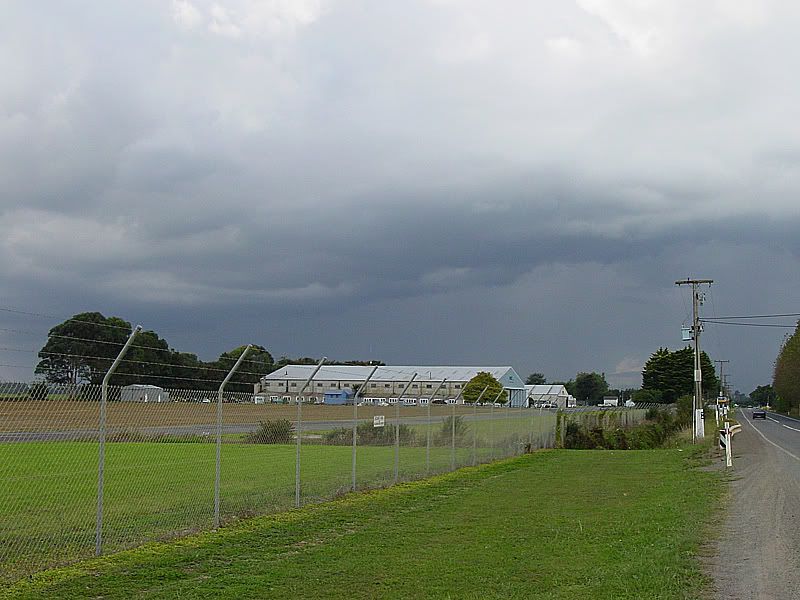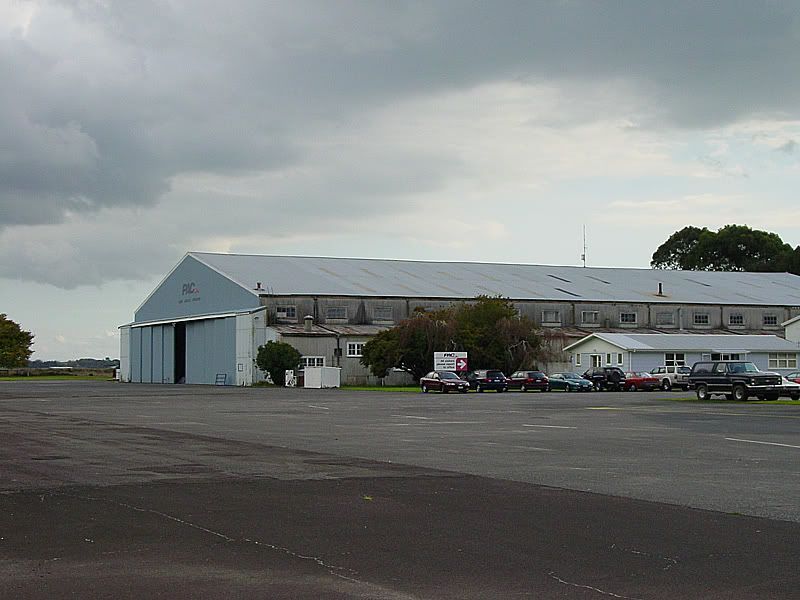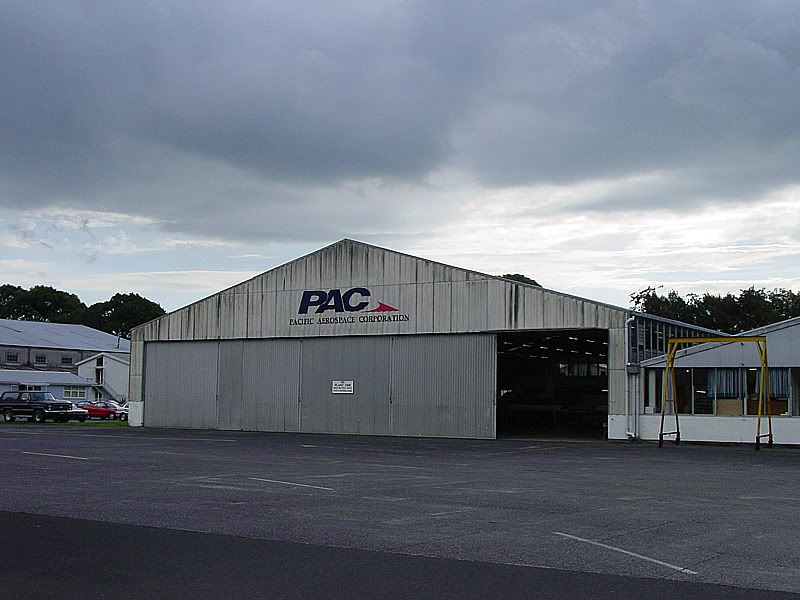
This airfield was a Repair Depot where airframes were repaierd and aircraft upgraded, etc. It later bacame a storage depot for disused aircraft
Runways - two hard runways, one of 5200 yrds and the other of 4500 yards
Meaning of Airfield Name -

Royal New Zealand Air Force

Between Hamilton to the north-west, and Cambridge to the south-east

This site was used as an aerodrome from 1933 onwards when the Waikato Aero Club relocated from their Te Rapa strip to this piece of land on Jack Steele's farm. The location had seen much aircraft usage before that when the initial airstrip was set up on Steele's farm in the late 1920's. The club bought the piece of land and this became Hamilton's main airstrip. It remains so today.
In 1942 it was decided that the aerodrome would be developed for RNZAF use. The Air Force planned to set up their main repair depot at Hamilton, and No. 1 Repair Depot would be established in both central Hamilton for engines, instruments and other components, and at Rukuhia where airframe work, painting, etc would be carried out, as well as test flights.
Land was acquired from six farms surrounding the existing airstrip to enlargen the airfeld to station size.
Work began on the airfield on the 7th of August 1942, under the leadership of Wing Commander Esmond A. Gibson. Two runways were laid by No. 1 Aerodrome Construction Squadron, who's members had escaped from Malaya and Singapore during the Japanese invasion there. The runways were large enough to receive all if the RNZAF's multi-engined aircraft at that time, except for the Catalinas and Sunderlands that arrived later in the war as they were non-amphibious flying boats of course. All single engined types could land there in 1942 except for the P-40 Kittyhawks. An extension later allowed this type to operate from the airfield safely.
The airfield officially opened as an RNZAF station on the 12th of August 1942. Construction on facilities continued though, and it wasn't till October 1942 that the building work was completed. Two new hangars were built, which remain on site today, and the third, No. 3 hangar from Whenuapai, was dismantled and brought to Rukuhia where it was erected for the duration of the war. After the war, it returned to Whenuapai where it's still in use. Smaller dome hangars were also erected during the war, and many other ancilliary buildings.
Later a further 266 acres was acquired to expand the airfield. 157 of these acres was acquired from Mr Thomas Henry Henderson on the 24th of December 1943 to expand again. At its peak, Rukuhia had 1800 officers and men working on station. From what I'm told no WAAF's worked there as all the clerical work for the station was done in town at RNZAF Hamilton. Most of the Rukuhia boys were billetted at the Narrows Camp, which is down in the gully beside the Waikato River.
The main function at Rukuhia was the base received aircraft that had been in the Pacific war zone, both RNZAF and US aircraft, which were eother due a major servicing or perhaps damaged. Also engines from the Pacific would be shipped down to the station. The Airframes would be stripped of its intstruments and engines that needed work and these would be taken into the various workshops in Hamilton. when engines had been overhaulled in the production line in Bledisloe Hall, they'd be mounted on a test truck and driven to the wilds of Te Rapa where there was no-one to disturb, and run till they were ready to be refitted to an airframe. these engine run tests occurred continuously at Te Rapa 24 hours a day, that's how many engines were coming through No. 1 RD.
The engines, instruments and bits would all return to Rukuhia and be refitted to the aircraft, which would have had all its skins and frames and other components checked and repaired where necessary too. Once reassembled, a test flight would check the workmanship, and then it would return to service.
As well as engineering trades working on the aircraft there, Rukuhia was also home to No. 203 Aerodrome Defence Unit. The ADU personnel were made up of new aircrew recruits who's usually done their basic training, sometimes not even that, and they were awaiting space on a course. They were gainfully employed patrolling perimeters, guarding picketed aircraft and performing other security related tasks. Meanwhile they also did at least 20 hours a month undergoing instruction in things like navigation and topics that would be useful to them when they moved onto their course.
An open day was held at RNZAF Rukuhia so the Waikato public could see both flying displays and also view the work on No. 1 Repair Depot.
Towards the end of the war the station also became home to an aircraft storage unit for older types being pulled out of frontline service and held in reserve. These were all inhibited and lined up on the airfield perimeter.

Opened 12th of August 1942
Closed ?

RNZAF Rukuhia came under the same command as RNZAF Hamilton
Wing Commander Esmond Allen Gibson _____________(Aug 1942 - Sep 1942)
Wing Commander JT Brown _______________________(Sept 1942 - Jan 1943)
Wing Commander W Temple _______________________(Jan 1943 - Apr 1944}
Wing Commander Alfred Morton Seafield (Mort) Manhire (Apr 1944 - Apr 1946)

Today RNZAF Station Rukuhia is Hamilton International Airport, and is owned by five regional councils. It has regular international and national flights, and is also home to New Zealand's aircraft production industry. Companies based on the airfield include Pacific Aerospace who manufacture military, agricultural and commercial aircraft. The Waikato Aero Club remains on site, as do other flying schools such as the international school, CTC. Also based at Rukuhia is James Aviation, a world leader in agricultural aviation. Many wartime buildings remain on site including two large RNZAF hangars, now used by commercial companies. Also several Married Quarter homes remain on the opposite side of the airfield. See more about Hamilton International Airport here

No. 1 Repair Depot
Certain parts of No. 1 RD were stationed at Rukuhia, no doubt the likes of aircraft assemly and testing after engine overhauls, and also repaints, etc. If anyone has any further information on what occurred at this unit within Rukuhia I'd like to know please.
Aircraft Storage Unit
From 1944 a number of aircraft were gradually withdrawn from use as newer models came into service. The older ones were sent to Rukuhia to be inhibited and stored till they were required for further use, or any other decision on their future was made. As it happens, most remained there and after the war were sold for scrap. The scrap dealers set up at Rukuhia so aircraft were seen on the airfield in storage awaiting the smelter into the early 1970's.
Rukuhia Today
The following photos were taken in late 2006 by Dave Homewood

The view of the former RNZAF Station hangars from the road,
when heading
from the terminal towards State Highway One

One of the WWII hangars, now occupied by Pacific Aerospace Corporation

Another of the WWII RNZAF hangars, also now occupied by PAC

Some of the anciliary buildings near the hangars. Their style and age lead me to believe these too were
part of the original WWII infrastructure
The Narrows Camp
A camp for airmen who worked at Rukuhia was established at the children's camp at The Narrows, an area beside the Waikato River where the river narrows to dangerous rapids. The airmen marched to and from this camp to Rukuhia each day.
Sources include 'Rukuhia: 1920-2000' by Colin Zuppicich, and personal interviews.





















